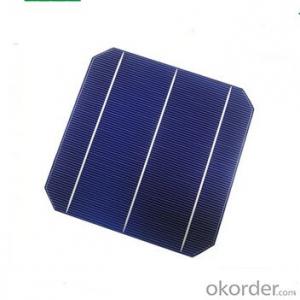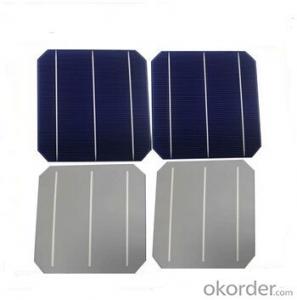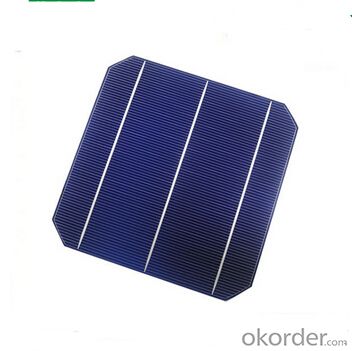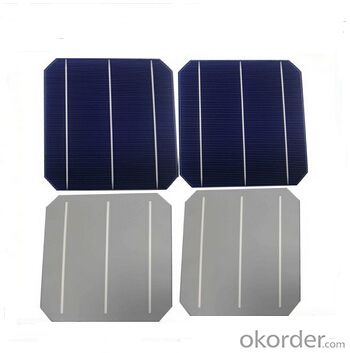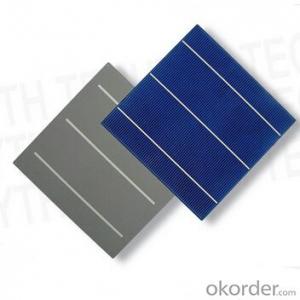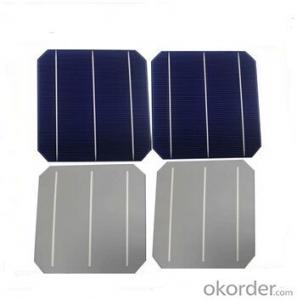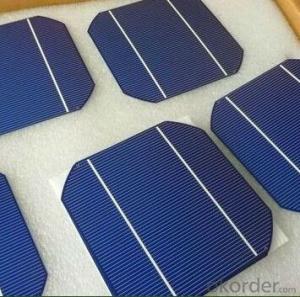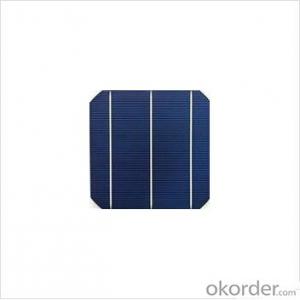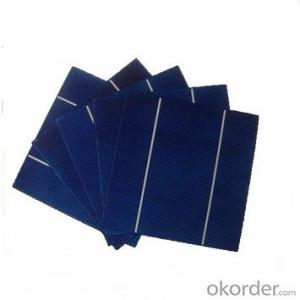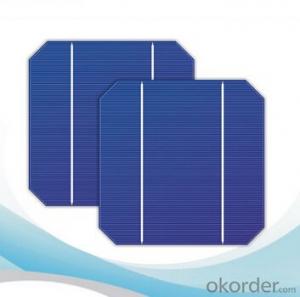Untabbed Monocrystalline Solar Cells High Quality 17.20
- Loading Port:
- Shanghai
- Payment Terms:
- TT OR LC
- Min Order Qty:
- 1000 pc
- Supply Capability:
- 100000 pc/month
OKorder Service Pledge
OKorder Financial Service
You Might Also Like
Solar Cells:
Solar cells is made by solar wafer, it has three categories of solar cell right now, monocrystalline polycrystalline and thin film,These cells are entirely based around the concept PN junction, which is the critical part of solar module, it is the part that can convert the light energy into electricity, the thickness is from 180um to 200um, with even busbars to conduct electricity, textured cell can decrease diffuse reflection; they are often electrically connected and encapsulated as a module. Photovoltaic modules often have a sheet of glass on the front (sun up) side, allowing light to pass while protecting semiconductor wafers from abrasion and impact due to wind-driven debris, rain, hail, etc. Solar cells are also usually connected in series in modules, creating an additive voltage. Connecting cells in parallel will yield a higher current;With high quality and stable quality. Our Cells can greatly improve the performance of Solar Modules.
Solar Cells Advantage:
• High efficiency and stable performance in photovoltaic conversion.
• Advanced diffusion technique ensuring the homogeneity of energy conversion efficiency of the cell.
• Advanced PECVD film forming, providing a dark blue silicon nitride anti-reflection film of homogenous color and attractive appearance.
• High quality metal paste for back surface and electrode, ensuring good conductivity, high pulling strength and ease of soldering.
• High precision patterning using screen printing, ensuring accurate busbar location for ease with automatic soldering a laser cutting.
Specifications:
Dimensions | 156x156 mm |
Diagonal | 220 mm |
Cell Thickness | 180/200 ± 20μm |
Front | Blue silicon nitride anti-reflective coatings |
3x1.5mm silver busbar | |
Back | Full-surface aluminum back-surface field |
3x3.0mm (silver/aluminum) discontinuous soldering pads |
Electrical Characteristics | ||||||
Efficiency code | Efficiency Eff(%) | Power Pmax(W) | Max.Power Current Ipm(A) | Short Circuit Current Isc(A) | Max.Power Voltage Vpm(V) | Open Circuit Voltage Voc(V) |
1760 | 17.60 | 4.28 | 8.097 | 8.561 | 0.529 | 0.631 |
1740 | 17.40 | 4.23 | 8.035 | 8.506 | 0.527 | 0.629 |
1720 | 17.20 | 4.19 | 7.973 | 8.454 | 0.525 | 0.627 |
1700 | 17.00 | 4.14 | 7.910 | 8.398 | 0.523 | 0.625 |
1680 | 16.80 | 4.09 | 7.847 | 8.335 | 0.521 | 0.623 |
1660 | 16.60 | 4.04 | 7.769 | 8.267 | 0.520 | 0.622 |
1640 | 16.40 | 3.99 | 7.690 | 8.203 | 0.519 | 0.621 |
Packaging & Delivery of Solar Cells
Carton Box Package and Deliver by air. It should be noticed that it should be avoid of water, sunshine and moist.
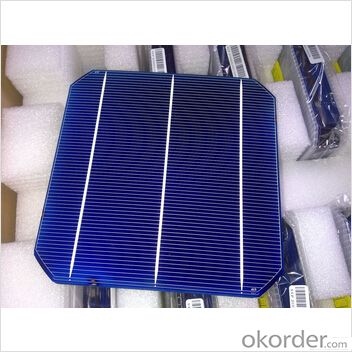
FAQ
We have organized several common questions for our clients,may help you sincerely:
①What price for each watt?
It depends on the efficiency of the solar cell, quantity, delivery date and payment terms.
②How long can we receive the product after purchase?
In the purchase of product within three working days, We will arrange the factory delivery as soon as possible. The pecific time of receiving is related to the state and position of customers.Commonly 7 to 10 working days can be served.
③Can you provide the peripheral products of the solar panels, such as the battery, controller, and inverter? If so, can you tell me how do they match each other?
Yes, we can, we have two companies for solar region, one is CNBM International, the other is CNBM engineering Co.
We can provide you not only the solar module but also the off grid solar system, we can also provide you service with on grid plant.
④What is your warranty of solar cell?
Our product can promise lower than 0.3% open box crack, we support claim after opening the box if it has crackm color difference or sth, the buyer should give pictures immediately, we can not accept the claim after the solar cell has assembled to solar panel.
• Timeliness of delivery
• ⑤How do you pack your products?
We have rich experience on how to pack the solar cell to make sure the safety on shipment, we could use wooden box or pallet as buyer's preference.
- Q: Can solar cells be used in developing countries?
- Yes, solar cells can be used in developing countries. In fact, solar energy is an ideal solution for providing electricity in remote areas without access to a reliable power grid. Solar cells are cost-effective, require minimal maintenance, and can be easily installed in various locations. Moreover, using solar energy can help reduce reliance on fossil fuels, improve energy accessibility, and contribute to sustainable development in developing countries.
- Q: Can solar cells be used in high-altitude areas?
- Yes, solar cells can be used in high-altitude areas. In fact, solar cells can actually be more efficient at higher altitudes due to reduced atmospheric interference and increased solar irradiance. However, the performance of solar cells can still be affected by factors like temperature and snow cover, which need to be considered for optimal utilization in high-altitude regions.
- Q: How do solar cells perform in regions with high levels of air pollution?
- Solar cells generally perform less efficiently in regions with high levels of air pollution. Air pollution can block sunlight and reduce the amount of light reaching the solar cells, thereby reducing their performance. Additionally, pollutants in the air can settle on the surface of the solar cells, forming a layer of dust or dirt, which further reduces their efficiency. Regular cleaning and maintenance of solar panels are necessary in polluted regions to ensure optimal performance.
- Q: Can solar cells be used for cooking?
- Yes, solar cells can be used for cooking, but not directly. Solar cells generate electricity from sunlight, which can then be used to power electric stoves or other cooking appliances.
- Q: Can solar cells be used for space applications?
- Yes, solar cells can be used for space applications. They are commonly used in space missions to generate electricity from sunlight. Solar cells are lightweight, durable, and efficient in converting sunlight into electrical energy, making them an ideal choice for powering spacecraft and satellites in the harsh environment of space.
- Q: How do solar cells handle electrical noise or interference?
- Solar cells do not directly handle electrical noise or interference. However, solar cell systems often include components such as inverters or power conditioning units that help mitigate electrical noise or interference by converting the direct current (DC) produced by the solar cells into alternating current (AC) that is more resistant to noise. Additionally, proper grounding and shielding techniques can be employed to minimize any potential interference from external sources.
- Q: What should I know about the Crystalline silicon photovoltaic cells?
- Crystalline silicon photovoltaic cells work by using crystalline silicon photovoltaic effect and power of the solar cell in generating the electrical power. It is not only used in the daily life but also in the industrail markets.
- Q: Can solar cells be used in desert regions?
- Yes, solar cells can be used in desert regions. In fact, desert regions are often ideal for solar energy production due to their high solar irradiation levels and abundant sunlight. The availability of vast open spaces in deserts allows for the installation of large-scale solar farms, which can efficiently harness solar energy to generate electricity. Additionally, the dry climate in deserts minimizes the risk of cloud cover, ensuring consistent solar energy production.
- Q: Is the Photovoltaic cell panel good to save the energy?
- Photovoltaic cell panel, known as solar panels, are assembled by a number of solar modules in a certain way on a plate, usually as a unit of photovoltaic array. They are very good in saving the energy.
- Q: How do solar cells handle shading or obstructions?
- Solar cells handle shading or obstructions by bypassing the shaded or obstructed areas and maximizing energy production from the unshaded portions of the cell.
Send your message to us
Untabbed Monocrystalline Solar Cells High Quality 17.20
- Loading Port:
- Shanghai
- Payment Terms:
- TT OR LC
- Min Order Qty:
- 1000 pc
- Supply Capability:
- 100000 pc/month
OKorder Service Pledge
OKorder Financial Service
Similar products
Hot products
Hot Searches
Related keywords
